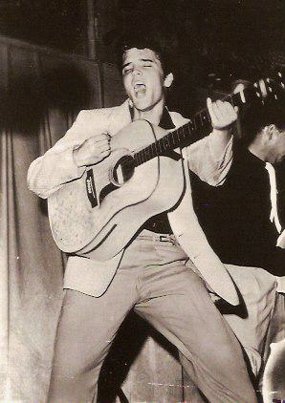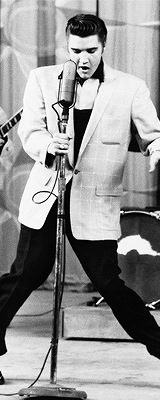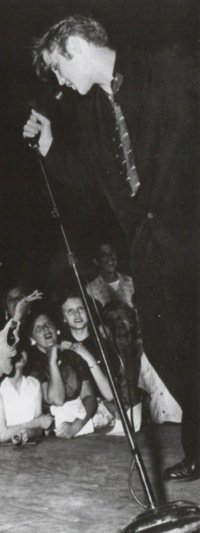Elvis History Blog
Elvis, Sweet Music & Rock'n'Roll:
A Tour of Long Beach Record Stores in '56
While history’s spotlight more often focuses on Elvis Presley’s “from-the-waist-up” appearance on The Ed Sullivan Show in 1956, it was an event earlier that year that elevated him to national prominence. His pelvic thrusts and phallic imagery while performing “Hound Dog” on The Milton Berle Show on June 5, 1956, prompted a flurry of condemnation from journalists. While most critics emphasized the vulgarity of Elvis’ movements, his performance also sparked a discussion of his vocal ability and the type of the music he was singing.

Ben Goss of the New York Daily News wrote, “popular music has reached its lowest depths in the ‘grunt and groin’ antics of one Elvis Presley.” In the New York Journal American, reviewer Jack O’Brien concluded that Presley, “can’t sing a lick,” and an exasperated John Crosby in the New York Herald Tribune declared, “One thing about Elvis Presley, the convulsive shouter of rock ’n’ roll songs—if that’s what they are: this may be the end of rock ’n’ fall and just conceivably a return to musical sanity. I mean where do you go from Elvis Presley?”
While the New York City press was united in its denunciation of Presley and their desire to see him run out of the music business, they accomplished just the opposite. They made Elvis a national celebrity overnight. Certainly, Presley’s popularity had been on rise, but in early June 1956 he was far from the superstar he would become. When he appeared on the Berle show, “Heartbreak Hotel” had been his only hit record. His second RCA single, “I Want You, I Need You, I Love You,” had only been released the week before. His debut LP was a big seller, but his second album wouldn’t come out until four months later. It would be even longer before his first movie appeared in theaters.
So, just how popular was Elvis Presley in June 1956, when the national press jumped all over him for his performance of “Hound Dog” on the Berle show? One journalist in Long Beach, California, decided to find out. His plan was to make the rounds of the retail record vendors in the Long Beach area and find out how popular Presley and rock ’n’ roll were compared to the “sweet music” that had dominated the record business up to that point. The results of his survey appeared in a Long Beach newspaper article on June 17, 1956. Since there was no byline on the article, we’ll just call the unknown author “Joe.”
• “Sweet Music Slows Rock and Roll”
The headline over Joe’s article read, “Sweet Music Slows Rock and Roll.” The long exposé opened with a statement from “juke box authority” Mrs. M. L. Christensen, an employee of the Melody Music Company in nearby Lakewood. “The kids are going from rock and roll to love and kisses,” she told Joe. “When we supply music now for a teen-age party, we always are told, ‘Send us rock and roll, of course, but send us sweet music, too!’”

She added that there were increasing requests for the new records by Patty Paige, Eddie Fisher, and The Chordettes. And, Joe asked, what about Elvis Presley, who had appeared in Long Beach’s Municipal Auditorium 10 days before? Mrs. Christensen responded:
“The kids are crazy about him. He has almost taken over the teen-agers. But the adults always ask ‘Who is he? Where did he come from?’ And this is a strange thing—there is a demand for him from all races and places, no matter where the juke boxes are—teen-age hangouts, cocktail bars, quiet restaurants. Everyone listens to him. Will he be a flash in the pan? Some come and go and some stay—maybe he will stay.”
Joe then reminded his readers of Frankie Laine, who was very popular in the record field in the early fifties. “When did you hear the last record by him? He disappeared when along came Presley with ‘Mystery Train’ and Pat Boone with ‘I Almost Lost My Heart.’”
Leaving the Melody Music Company, Joe made his way to the General Amusement Company in Long Beach. There juke box insider Mona Erhlich told him there had been a revival of demand for oldies like “Star Dust” and “The Angel Sings,” along with anything by Dean Martin, Nat King Cole, and Roger Williams. “Places where there is much demand on juke boxes for rock and roll are places that are lively and jumping,” Mona explained. “For instance, ‘Corrina, Corrina,’ an old song has been brought back with a rock and roll beat. Another favorite is ‘Long Tall Sally.’”
When Joe asked about Elvis Presley, Mona acknowledged a demand, but attached a limitation to it. “Oh yes,” she said. “We have tremendous requests for ‘Heartbreak Hotel,’ ‘You’re a Heartbreaker,’ ‘Blue Moon of Kentucky,’ ‘Blue Suede Shoes,’ ‘I’ve Got a Woman.’ But here is something—people want Elvis Presley, but they don’t stay with him. They’ll order four or five of his records and then they’ll say, ‘That’s enough Presley. Give us something else.’”
• Young girls ask for Presley’s “I’ve Got a Woman”
The next stop on Joe’s tour was Humphrey’s Music Company on Pine Avenue, where he questioned Leroy Lawrence, a clerk in the record department. Leroy summed up the current market this way: “The young teen-ager wants rock and roll, the older teen-ager wants modern jazz or ‘listening music,’ but the general public keeps right on wanting sweet music, such as Jackie Gleason, Mantovani, and Paul Weston records.”
Next, Joe took his notebook to the mall in Los Altos, where The Music Box catered to students from State College, City College, Wilson High School, and nearby Stanford and Marshall Junior High Schools. “You can tell the age of a person by the records he buys,” store owner Marianne Sumner told Joe. “First it’s rhythm and blues. It’s jazz next, then it’s progressive jazz, and about their last year in college, students begin to show a love for the classics.”

When Joe dropped Elvis’ name, Marianne revealed that he was so popular with the younger set that she was having trouble keeping his records in stock. How young? Like all the record store owners he had talked with, Marianne admitted to being “a bit discomfited when a 9, 10, 11 or 12-year-old comes in and asks for Presley’s ‘I’ve Got a Woman.’ The idea of the song is that the lady is on the other side of town.”
Joe then strolled back over to Pine Avenue to talk with Edna Elder, manager of the record department at Schirmer Music Store. “We noticed the trend from rock and roll to sweet music as much as six months ago,” Edna disclosed. “Kids now prefer the ballads—love songs and the sweeter, slower, dreamier type of music, for instance those with vocals by Frank Sinatra, Perry Como and Dean Martin. They have switched from rock and roll to music for listening, rather than dancing.”
But a couple of blocks further down, Joe heard just the opposite point of view. “Rock and roll still is the biggest thing in the single record sale,” declared Bob Morey, record department manager at “Morey’s” on Pine. “Most of the records that achieve any sales in the pop field actually have a rock and roll flavor. In the Western field there, of course, is Presley. And Bill Haley, one of the most consistent sellers in the rock and roll department, originated as a Western artist.” Morey added, “Teen-agers buy rock and roll; adults buy some. And parents buy for the kids what the kids want—rock and roll!”
Agreeing with him was Del Lear, owner of Joe’s final stop, Bixby Knolls Music Center on California Place. “It’s all rock and roll,” Lear asserted. “We’re not selling anything else.”
• Conclusions: Sweet Music vs. Rock and Roll
At the end of his article, Joe declined to draw any conclusions from what he heard during his tour of Long Beach’s record outlets. However, keeping in mind that Joe’s research was very limited in scope and location, a few revelations about Elvis Presley’s ability to sell records in June 1956 jump out from the comments of those record vendors.
First, at that point in time, teenagers were buying a mixture of “sweet music” and rock ’n’ roll. The latter style had not yet taken over the charts, radio play lists, and record sales. The recent railing against Elvis by the New York journalists would hasten the assent of rock ’n’ roll through the rest of 1956.
Second, the revelation that girls as young as 9 and 10 were buying Elvis records in Long Beach in mid-1956 fits with what we now know—Elvis’ main demographic group then was primarily young girls. He was more popular in junior high schools than in high schools. Older teenage girls, especially those of college age, had already formed their tastes in music before Elvis came along.
Finally, the fact that most record sellers didn’t mention Elvis until Joe asked specifically about him indicates that, while Presley’s records were selling well, they were not yet dominating the market in June 1956. As one of the Long Beach record sellers noted, at that time Elvis was still considered a “Western” singer by many in the business.
The Berle show on June 5 was the first time Elvis performed “Hound Dog” on TV, and the uproar of criticism that his provocative style triggered in the nation’s press soon made Presley the face of rock ’n’ roll in the country. Steve Allen’s attempt to reign in Elvis on his show a month later only enhanced Presley’s rock ’n’ roll credentials. Ahead in the latter half of 1956 were appearances on The Ed Sullivan Show and blockbuster hit records “Hound Dog,” “Don’t Be Cruel,” and “Love Me Tender.”
New York critics John Crosby, Ben Goss, and Jack O’Brien all tried to bring Elvis Presley down with their caustic criticism. In the end, by throwing him into the national spotlight, they hastened his coronation as the King of Rock ’n’ roll. — Alan Hanson (© March 2016)

"This is a strange thing—there is a demand for him from all races and places, no matter where the juke boxes are—teen-age hangouts, cocktail bars, quiet restaurants. Everyone listens to him."










